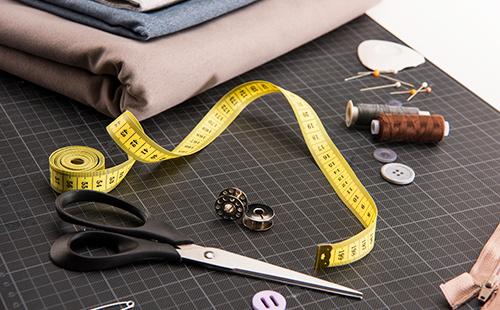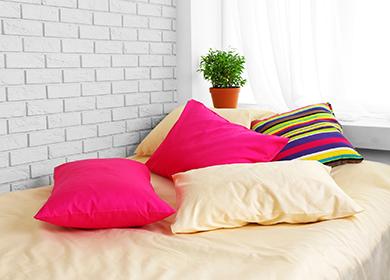The content of the article
The decision to make bedding yourself has several advantages. Three arguments support this:
- Perfect fit. All the elements of the set will be exactly suitable for the bed and bedding, which is not always noted in relation to purchased linen.
- Perfect kit. You can sew as many pillowcases and duvet covers of the same color as needed. In ready-made sets, the quantity is standard.
- Perfect design. You can choose a fabric of any color that fits perfectly into the interior of your bedroom.
The choice of material: what sleep better
Having decided on the independent production of a sleeping set, it is necessary, first of all, to decide which fabric is best to sew bed linen from. The material must be safe, body-friendly and at the same time durable. There are several most suitable options.
- Chintz. A relatively inexpensive fabric, which has a large selection of colors. The material is light and pleasant to the body, but thin enough. Count on the durability of cotton underwear is not worth it.
- Calico. Dense material with a huge variety of colors that do not fade with time. The peculiarity of the fabric is that during operation it becomes softer without losing strength.
- Flannel. A pleasant body material, which is usually used for sewing baby diapers. Given that its properties are similar to calico, it can also be used for bedding.
- Satin. It is soft and lightweight but very durable. Given these characteristics, its price is quite high.
- Linen. It has a limited range of colors, as it is difficult to color. Nevertheless, the fabric is expensive due to its strength, safety and hypoallergenicity.
- Silk. Beautiful in appearance, smooth to the touch and fairly dense fabric. Such material does not cause allergic reactions and judging by the reviews is very durable.
How much fabric do you need
Quality fabric for bedding is an expensive pleasure. Therefore, it is important to accurately determine the size of future patterns, so as not to overpay for extra centimeters. At the same time, the amount of material should take into account all allowances and possible shrinkage. The consumption of material depends on what the cutting will be, with a cutout from below or in the middle, 2 bedroom or one and a half. It is not difficult to open the bed linen, especially if you look at the master class of already experienced craftswomen.
Standard Size Chart
If the bed and bedding are fully consistent with the standard, a table of sizes of bed linen will help determine the amount of fabric.
Table - Standard bedding sizes
| Type of | Sheet | Duvet cover | Pillowcase | |
|---|---|---|---|---|
| Single | Length | 200 | 200 | 70 |
| Width | 110 | 135 | 50 | |
| 1,5 bedroom | Length | 200 | 220 | 70 |
| Width | 150 | 160 | 50 | |
| Double | Length | 210 | 210 | 70 |
| Width | 175 | 180 | 70 | |
| Euro size | Length | 240 | 220 | 70 |
| Width | 200 | 200 | 50 | |
| Family (with two duvet covers) | Length | 200 | 210 | 70 |
| Width | 180 | 150 | 70 | |
| Baby | Length | 138 | 135 | 60 |
| Width | 120 | 120 | 40 | |
| For a crib (newborn baby) | Length | 140 | 135 | 45 |
| Width | 110 | 100 | 35 |

How to calculate the quantity
First of all, you need to calculate how much fabric you need to sew bedding. Regardless of whether you use standard sizes or take measurements yourself, there are certain formulas. For convenience, draw sketches of patterns with signature sizes.
Table - Calculation of the amount of fabric per bed set
| Thing | Component lengths of the pattern | The components of the width of the pattern |
|---|---|---|
| Sheet | - 1 length of the mattress; - seam allowance of 3-5 cm | - 1 width of the mattress; - 2 heights of the mattress; - 20-40 cm in the doorway; - seam allowance of 3-5 cm |
| Duvet cover | - 1 length of the blanket; - seam allowance of 3-5 cm | - 2 widths of the blanket; - seam allowance of 3-5 cm |
| Pillowcase | - 2 pillow lengths; - 20-30 cm for the valve; - seam allowance of 3-5 cm | - 1 pillow width; - seam allowance of 3-5 cm |
How to sew bedding with your own hands. Let's analyze step by step
At first glance, sewing a bed set seems to be a simple and understandable task. But, getting started, it becomes clear that the process has a lot of nuances. Therefore, beginner needlewomen just need step-by-step instructions on how to sew bedding.
Sheet
The scheme for sewing a sheet is the simplest. Therefore, it is recommended to start with this element. The process includes four stages.
- Fold the fabric two times by 1.5 cm and bind.
- For convenience of further work, iron the hem.
- Sew 0.2 cm from the fold.
- Repeat the algorithm on the remaining three sides.
Duvet cover
To properly sew bedding, namely a duvet cover, you will need some skill. Production includes six stages.
- Fold the workpiece in half in width across the front.
- Decide where exactly the hole for the blanket will be located and make appropriate markings on the fabric with a felt-tip pen.
- Sew the sides of the product to the marks. From the edge you need to retreat 1.5-2 cm.
- Double-tilt, as in the case of the sheet, process the edges of the blanket hole.
- Iron all seams, unscrew the product and again go around the edges with an iron.
- To hide unprocessed sections and fix the seams, stitch the product, 0.5-0.7 cm indent from the edges.
Pillowcase
Making pillowcases at home is perhaps the most difficult task. To make the product perfect, clearly follow the five-step instructions.
- Sew the edges in width with a double hem.
- Fold the fabric “face” outward so that the valve is between two layers of material.
- With a distance of 0.3 cm from the edge, stitch the product on both sides.
- Turn the product inside out and sew again at a distance of 0.5 cm from the edge to hide the uncut sections.
- Unscrew and iron the seams again.
Buying finished bedding is a troublesome and, sometimes, thankless task. Even if you manage to find a quality set with a beautiful color, it is not a fact that it is perfect for your bed, blanket, pillow. Therefore, more and more housewives are eager to learn how to sew a set of bed linen. The design of linen fabric can be selected from a photo on the Internet, and sew it yourself. Of course, if sewing is your thing. A sewing machine plus a little perseverance - and you can count on success.

